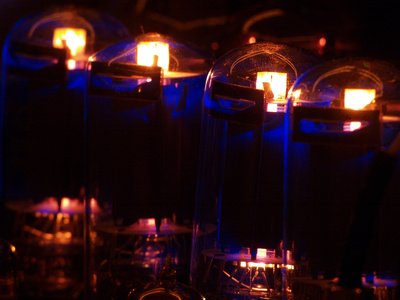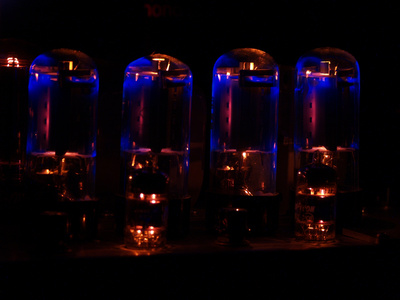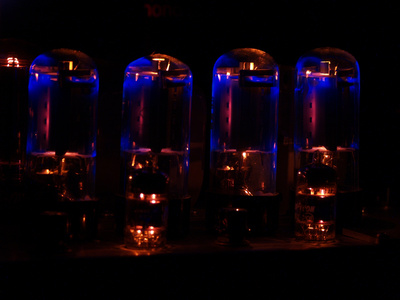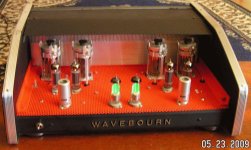Here is my 6П3С-Е prototype:
Interesting arrangemet.
You have all connectors, switches and pots at the same side.
Can you tell how did you come into such design and what is the main purpose of the use ?
Some words about the construction of the output stage would be interesting.
This one was a 30 second exposure at ISO100...
I couldn't help but notice the tinge of color along the plate seam on all four power tubes. I'm not referring to the blue, it's the pinkish-red that has me curious. Can you really see that with the eye in a darkened room, or is that just the digital camera being extra sensitive to IR?
I have some old Russian 6550 tubes that also show signs of plate color, even well below their dissipation ratings. The odd thing is that the coloration only appears along one side of one of the plate seams. Both tubes in this amp are doing it, but one tube is rotated 180 degrees so the color is on the opposite side. And yes, you can clearly see it with your eyes.

http://i69.photobucket.com/albums/i43/Ty_Bower/Simple SE/P1130044.jpg
Hi Ty, it's a time exposure photo so it just exaggerates the light intensity depending on how long the exposure was. If it was IR, the camera would have to convert its frequency range up to the visible spectrum before we could ever see it. That's how night vision devices work.
This exposure was a bit longer than that required by our eyes requirements in that same light level. It's really difficult to get it exactly the same as our eyes see without a lot of trial/error exposure timings and ISO settings.
But for tube shots the extra intensity of a longer exposure is nicer looking than reality anyway.
Wave, that's what I meant actually. I just used the wrong words. Tired.
..Todd
This exposure was a bit longer than that required by our eyes requirements in that same light level. It's really difficult to get it exactly the same as our eyes see without a lot of trial/error exposure timings and ISO settings.
But for tube shots the extra intensity of a longer exposure is nicer looking than reality anyway.
Wow!
Think bigger Todd: nice wall paper!
Wave, that's what I meant actually. I just used the wrong words. Tired.
..Todd
Last edited:
Interesting arrangemet.
You have all connectors, switches and pots at the same side.
Can you tell how did you come into such design and what is the main purpose of the use ?
Some words about the construction of the output stage would be interesting.
I did not have all connectors on the same side. Power socket and 8, 16 Ohm sockets are on the rear panel. They are flat, so well protected when the amp is laid on it's back. The amp was designed for double usage: for high quality PA and for home stereo. For PA ins/outs are better on rear panels, controls on front panel. For home stereo it is fashionable to have connections on front.
How did I come to this construction? I don't know; probably, the main reason was ergonomics that we learned in university. I tried to make the simplest and optimized construction. Convection path designed such a way so hot air from tubes going up creates forced flow through transformer compartment, that sucks an air from under chassis.
Output stages use 4K P-P transformers. Tubes are paralleled, so each 6L6 sees 8K P-P load line, for lower distortions. Also, screen grids are powered from low stabilized voltage supply, that additionally decreases distortions in output stage. Phase splitter is combined Concertina and LTP. All 3 driver stages are direct connected and use triodes (6N2P input/concertina, 6N6P LTP).
The project was called Pyramid. I found it too complex, and next class AB tube amps were called Pyramid-V and Pyramid-VII; they had improved design, and military tubes GU-50 in output stages. Input/Concertina use 6F12P, LTP uses 6N6P tubes in Pyramid-V. In Pyramid 7 I used 6F12P input, 2 x 6P15P LTP driver. Pyramid-V-M and Pyramid - VII had parallel feedback by voltage in output stages. There are other projects, Pyramid-8 and Pyramid-VII-M, but they are not finished yet.
www.wavebourn.com • View topic - Pyramid-VII: home stereo vacuum tube amp
Attachments
I couldn't help but notice the tinge of color along the plate seam on all four power tubes. I'm not referring to the blue, it's the pinkish-red that has me curious. Can you really see that with the eye in a darkened room, or is that just the digital camera being extra sensitive to IR?
I have some old Russian 6550 tubes that also show signs of plate color, even well below their dissipation ratings. The odd thing is that the coloration only appears along one side of one of the plate seams. Both tubes in this amp are doing it, but one tube is rotated 180 degrees so the color is on the opposite side. And yes, you can clearly see it with your eyes.

http://i69.photobucket.com/albums/i43/Ty_Bower/Simple SE/P1130044.jpg
Hi Ty, it's a time exposure photo so it just exaggerates the light intensity depending on how long the exposure was. If it was IR, the camera would have to convert its frequency range up to the visible spectrum before we could ever see it. That's how night vision devices work.
This exposure was a bit longer than that required by our eyes requirements in that same light level. It's really difficult to get it exactly the same as our eyes see without a lot of trial/error exposure timings and ISO settings.
But for tube shots the extra intensity of a longer exposure is nicer looking than reality anyway.
Wave, that's what I meant actually. I just used the wrong words. Tired.
..Todd
Nope, the seams on all four of the tubes glow like that. Not quite that bright, but plenty bright enough to see with the naked eye.
Nope, the seams on all four of the tubes glow like that. Not quite that bright, but plenty bright enough to see with the naked eye.
Yes, I see it now in your first daylight photo. I wonder how long the tubes will last like that? I also wonder exactly what it was the Russian assembly workers did "wrong" to make them act that way? I've confirmed with several others that some versions of the 6550 do it, but this is the first I've noticed in the 6p3s.
I found that 6P3S (6П3С originally) are fair copies of RCA 6L6G, but they are NOS and sometimes gassy; also they are Russian so have spread of parameters wider than barn gates.
I still have some left. I want to try and bake it at 150 degrees C in an oven, let's see if it reduces gases.
What is your recipe for baked 6П3С?
What is your recipe for baked 6П3С?
I have no recipe yet; I don't know how high temperature can Bakelite sockets survive. Can you find ГОСТ 8376-57 Government Standard? It should contain all specs for 6П3С tube.
If it was IR, the camera would have to convert its frequency range up to the visible spectrum before we could ever see it.
Many older digital cameras were sensitive in the IR region. My older Sony DSC-F828 makes a good glowing tube detector. I can turn up the juice on some tubes until they glow and then back off until there is no visible glow in a totally dark room. Take pictures with the old Sony and the new Canon. Glow is visible in the picures taken with the Sony, but not with the Canon. If I back the dissipation off about 2 more watts on a big sweep tube there is no glow visible in either picture.
I would expect that running these tubes this close to the glow region will shorten their lives.
I have some old Russian 6550 tubes that also show signs of plate color, even well below their dissipation ratings.
You mean Soviet era 6550 Russian tubes (I could not recall anything close but 6P3S-E which is analog of 6L6 and have only 20W anode dissipation power)? Or new production from SED, Sovtek, etc.?
Nice shots! Those last two would make lovely desktop photos. Do you have a high(er) res version you could email me?
..Todd
I'll send them to you in a jiffy sir. Thanks for the great complements!
Yes, I see it now in your first daylight photo. I wonder how long the tubes will last like that? I also wonder exactly what it was the Russian assembly workers did "wrong" to make them act that way? I've confirmed with several others that some versions of the 6550 do it, but this is the first I've noticed in the 6p3s.
That pic was taken with my iPhone too and I never even noticed that glow!
I'm wondering if that big Sylvania 5U4G along with the GE 5U4G is letting more voltage through than just running the dual GE's. I ran the Sylvania/GE combo on the 6L6's and never noticed that glow, then again I wasn't looking for it either. Hmm...
taj, the email app in the forum doesn't look like I can send pics, so here's the links to each below the thumbnails.

http://charlest.zenfolio.com/img/s9/v13/p129029475.jpg

http://charlest.zenfolio.com/img/s8/v12/p361590860.jpg

http://charlest.zenfolio.com/img/s9/v13/p129029475.jpg

http://charlest.zenfolio.com/img/s8/v12/p361590860.jpg
Well after posting the full rez links to my images and recieved no thanks or anything in return, I've just been keeping to myself sitting here enjoying my system.
However, at any rate I just ordered another set of tubes, this time a matched set of NOS NIB 6N3C-E tubes. From what I gather, they are supposed to be the same as the 6P3S-E tubes. I'll see how these compare to the ones I'm using now.
However, at any rate I just ordered another set of tubes, this time a matched set of NOS NIB 6N3C-E tubes. From what I gather, they are supposed to be the same as the 6P3S-E tubes. I'll see how these compare to the ones I'm using now.
I would be interested to hear if the 6P3S-E sound any different for better or worse. You may have to re-bias to run them, or at least check the bias. One thing I know is they cost more than 6P3S, so demand must be higher, so they must doing something right! I have run 6P3S and been quite happy with them. I accidentally found out the ones I have will take a lot more than their ratings suggest in power dissipation. They do have that blue glow, that's just what they do.
Hey chops,
Didn't know about them until now. Thanks for the photos! They're going wallpaper ASAP! Well done.
..Todd
Wow;
thank you Chops!
It looks great as a background on my display!
You're welcome guys. Sorry about that snide comment last night. I was in a bit of a sour mood (work related) and I guess it got the best of me and I let it out a little on here. I'm glad you like the pics. Do enjoy them!
I would be interested to hear if the 6P3S-E sound any different for better or worse. You may have to re-bias to run them, or at least check the bias. One thing I know is they cost more than 6P3S, so demand must be higher, so they must doing something right! I have run 6P3S and been quite happy with them. I accidentally found out the ones I have will take a lot more than their ratings suggest in power dissipation. They do have that blue glow, that's just what they do.
The ones I got are the highly praised ones that are supposed to be the "giant" crushers and gives the top NOS tubes a run for their money. We'll see how they compare and I'll certainly post the results here.
As for the bias, this amp has a fixed bias, so there's not a whole lot I think I can do in that department. Of course, I suppose I could probably solder in some new and different value resistors, if that's how it's done in this amp.
The blue glow of the tubes is not as much of a concern as the thing that really concerns me is the one seam on all four tubes glowing an orange-red. This is why I ordered the new tubes. They are supposed to be much better built and can handle higher voltages.
Also, concerning the blue glow and the seams glowing, I tested the tubes on my B&K solid state tester and all four tubes are perfectly fine. No gases, leaks, shorts or anything. I also have a really nice HP desktop DMM that I would love to probe around with under the hood of the Baldwin amp, but not knowing what to probe, I don't dare do it. I would really like to know what the voltages and bias is at on this thing, but like I said, I'm not going to just go in there and start probing around.
Just for fun... And no, those aren't scuff marks and such on the tester. That's from one of the many camera apps I have on my iPhone to give it that "vintage" look to it.
An externally hosted image should be here but it was not working when we last tested it.
An externally hosted image should be here but it was not working when we last tested it.
An externally hosted image should be here but it was not working when we last tested it.
Last edited:
Just a little more fun to show you what I mean about the iPhone camera apps. 
An externally hosted image should be here but it was not working when we last tested it.
An externally hosted image should be here but it was not working when we last tested it.
An externally hosted image should be here but it was not working when we last tested it.
taj, the email app in the forum doesn't look like I can send pics, so here's the links to each below the thumbnails.

http://charlest.zenfolio.com/img/s9/v13/p129029475.jpg

http://charlest.zenfolio.com/img/s8/v12/p361590860.jpg
It's scary how a picture of glowing tubes can make a grown man turn into a pile of goo!
Glad I'm not the only one that does that.Sorry about that snide comment last night. I was in a bit of a sour mood (work related) and I guess it got the best of me and I let it out a little on here.
..Todd
- Status
- This old topic is closed. If you want to reopen this topic, contact a moderator using the "Report Post" button.
- Home
- Amplifiers
- Tubes / Valves
- Excellent NOS Russian 6Pi3C/6N3C (6L6GC) Tubes...
